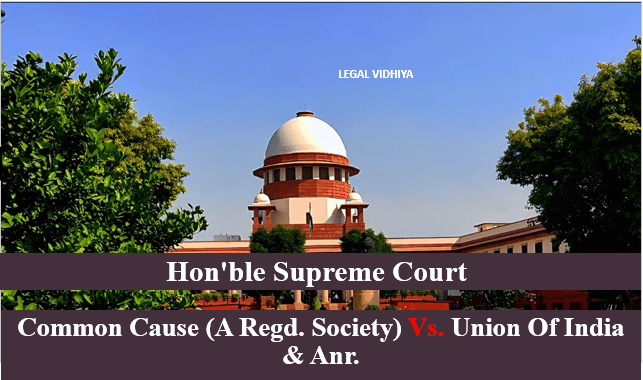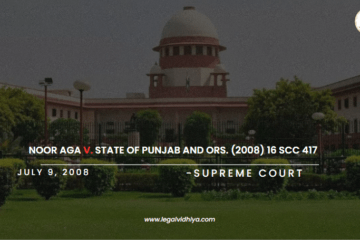
| CITATION | (2018) 5 SCC 1, AIR 2018 SC 1665 |
| DATE OF JUDGMENT | 9 March, 2018 |
| COURT | Supreme Court of India |
| APPELLANT | Common Cause (A Regd. Society) |
| RESPONDENT | Union of India and Another |
| BENCH | Chief Justice D. Misra, Justice A. M. Khanwilkar, Justice D. Y. Chandrachud, Justice A. K. Sikri and Justice A. Bhushan. |
INTRODUCTION
The Common Cause, a registered association, petitioned for a declaration that the right to die with dignity was part of the right to live with dignity under Article 21 of the Constitution. It also asked the state to create suitable procedures to allow people in poor health or terminally ill to execute Advance Medical Directives or living wills. The Court analysed both Indian and foreign precedence, notably the decision in K.S. Puttaswamy & Anr. Vs. Union of India & Ors. ((2017) 10 SCC 1), before concluding that the right to die with dignity was a basic right under Article 21. The Court also approved the use of Advance Medical Directives, saying that this mechanism may protect individual autonomy while also providing dignity in death. The Court went into significant depth about the evolution of the right to privacy, stressing that privacy is important to human dignity, without which liberty cannot be realised. The right to privacy was also seen as essential to bodily autonomy, integration, and freedom of choice, all of which would be safeguarded as fundamental rights. The Court took note of the US decision in In Re Quinlan in balancing State interest and individual privacy, which stated that as bodily integrity was increasingly compromised and chances of recovery decreased, the right to privacy increased and state interest diminished.
FACTS OF THE CASE
- The denial of the right to die prolongs pain and agony, both physical and mental, which the petitioner Society seeks to end by making an informed choice by clearly expressing their wishes in advance, known as “a living will,” in the event that they become unable to express their wishes.
- The petitioner Society contends that any such practice would be contrary to the law established by this Court in Gian Kaur and Aruna Shanbaug.
- In Gian Kaur v. State of Punjab, the Supreme Court’s Constitution Bench ruled that both euthanasia and assisted suicide are illegal in India. According to the Court, the right to life guaranteed by Article 21 of the Constitution does not include the right to die (vide SCC para 33).
- In terms of the Aruna Shanbaug case, Aruna Shanbaug correctly read the Constitution Bench’s ruling in Gian Kaur and concluded that euthanasia can be legalized in India only through proper legislation.
- The Bench in Aruna Shanbaug was of the opinion that in Gian Kaur, the Constitution Bench held that euthanasia could only be made legal by legislation. This case was then referred to this Court’s Constitution Bench for an official opinion.
- All of the foregoing was mentioned in this writ petition.
ISSUES RAISED
- Whether the right to life, enshrined in Article 21 of the Indian constitution, includes the ability to die with dignity.
- Is the practice of passive euthanasia permitted in India under the living will of patients?
- Is there a distinction between passive and active euthanasia?
- Is there any progress proposed by India’s law commission regarding euthanasia provisions?
- Does an individual have the right to refuse medical treatment that includes the removal of a life-sustaining device?
CONTENTIONS OF APPEALENT
- Every person has the right to make decisions about his or her own life. Assume he is in a death situation or is suffering from an incurable sickness with no hope of recovery. Is it morally acceptable to employ medical technology to prolong his agony by slowing the death process?
- The right to die with dignity is a fundamental right secured by and inherent in the right to life. The right to die in pain or without pain is essential to one’s bodily autonomy and integrity.
- Petitioners claim that the concept of individual autonomy is supported by the right to privacy and also falls under the fundamental principle of liberty. They utilized KHARAK SINGH v. STATE OF claim and OTHERS, GOVIND v. STATE OF MADHYA PRADESH, and other cases to back this claim. Numerous laws from numerous countries, including the United States, the United Kingdom, Australia, Singapore, and Canada, have been cited.
- They referred to India’s 241st Law Commission on Passive Euthanasia- Following Aruna Shanbaug’s verdict, a commission called “Passive Euthanasia a Relook” presented a full report.This report looked into the term Euthanasia. It comes from the Greek words EU and Thanatos, which mean “good death” or “merciful killing.” Francis Bacon coined the term euthanasia in the 17th century to allude to a painless and cheerful dying.
- The report also defines the word or point of view of British people.The Medical Ethics Selection Committee in England defines Euthanasia as “deliberate action taken with the intention of ending life and relieving pain and suffering.” The study supported the Armidale case’s conclusion that any forced medical assistance amounted to assault and violence.
CONTENTIONS OF REPONDENT
- The Hippocratic oath forbids doctors from murdering people voluntarily. It is the oath that Doctors once took before entering medical practice. The advancement of medical knowledge to provide relief from pain and suffering, rehabilitation, and treatment of so-called disease would be hampered.
- An individual may wish to die at some point in time; yet, this wish may not endure long, and the chance of a change of heart is always available. As a result, it can only be interpreted as dismal mental stress. Suffering is a mental state that varies from person to person and location to location. As we all know, each person is unique in their own way, thus it differs.
- Medical science advancements have made several previously unattainable treatments for cancer and other grave illnesses possible. It must be overlooked that a person suffering from a mental disorder who intends to die can be treated by competent psychiatrists.
- In this case, a critical concern arises: may a doctor pronounce whether a patient’s sickness is incurable based on their experience or academic expertise? Medical officers who will perform euthanasia may experience severe psychological stress and anguish. As a result, this solution produces or supplies another major issue.
JUDGEMENT
The Court pointed out that the right to die with dignity was a basic right, as declared by a Supreme Court Constitution Bench in the case of Gian Kaur. The Court further stated that the Gian Kaur decision did not create the idea of passive euthanasia. The Court explored the distinction between active and passive euthanasia, with active euthanasia requiring an overt action and passive euthanasia being the act of withdrawing life support. It ruled that the Court erred in Aruna Shanbaug by stating that passive euthanasia could only be implemented through legislation.
The Court relied on the decision. In re Quinlan (1976), the New Jersey Supreme Court determined that as the outlook improved, the patient’s interest waned, the state’s interest waned, and the individual’s right to privacy in terms of physical autonomy got stronger. If the persons themselves were unable to assert their privacy, a guardian could do so on their behalf. The Court held that the right to privacy required safeguarding the integrity of individual choice in the intimate sphere of death decisions, and that the protection of these rights was an emanation of the right to privacy because they were related to the fundamental right to life and personal liberty guaranteed by the Constitution.
ANALYSIS
With regard to living wills, the Court determined that there was clear evidence of acceptance of the idea of Advance Medical Directives. This country. It went on to say that having the ability to execute an Advance Medical Directive was a step towards protecting the right to self-determination and bodily integrity. In the situation of patients who were unable to make an educated decision, a ‘best-interest’ position might be used, allowing a guardian to step in and make the decision on their behalf. The right to privacy, as was explained in the case of Justice K.S. Puttaswamy vs. Union of India (2017 (10) SCC 1), was extensively examined in the case. To autonomy and liberty.
In this case, the Court relied on extracts from all six judgements. In addition to Indian examples, the Court looked at decisions from other countries and considered the relationship between the right to privacy and its implications for euthanasia. Thus, The Indian Supreme Court ruled that the right to die with dignity is a fundamental right. The bench ruled that the execution of a living will and passive euthanasia were both legal. The right to life and liberty envisioned in Article 21 of the Constitution is meaningless unless it includes individual dignity.
With the passage of time, the Court has broadened the scope of Article 21 to include individual dignity.
CONCLUSION
This case was not about life and death; it was about a person’s sufferings and excruciating pain, which rendered his life completely meaningless, devoid of dignity and integrity. And the Hippocratic Oath, which the union invoked on his behalf, was simply an excuse to conceal his pains under oath. The bench views this matter positively, stating that it is fair to suggest that a person should suffer as normal in the event of terminal disease due to their oath. And the court emphasized the distinction between not attending to patients and easing their agony.
The bench would like to highlight that it is the role of the state to preserve the dignity and integrity of its citizens in their defenceless situation. Right to life is fundamental right but to live a dignified life there are many things which are essential for their living like food, shelter and clothes are basic but to live in civilized society, dignity and integrity are a must. At last, I like to take note Father of Nation Mahatma Gandhi, said that “it is beneath human dignity to lose one’s individuality and become a mere cog in a machine”
REFERENCES
- SCC Online
- Smt. Gian Kaur vs The State of Punjab (1996) SCC (2) 648
- Aruna Ramachandra Shanbaug v. Union of India, (2011) 4 SCC 454 s 140
- Airedale NHS Trust v Anthony Bland [by his guardian ad litem, the Official Solicitor of the Supreme Court] (1993) AC 789 HL.
This Article is written by Ashi Sangwan student of Guru Gobind Singh Indraprastha University (FIMT); Intern at Legal Vidhiya.
Disclaimer: The materials provided herein are intended solely for informational purposes. Accessing or using the site or the materials does not establish an attorney-client relationship. The information presented on this site is not to be construed as legal or professional advice, and it should not be relied upon for such purposes or used as a substitute for advice from a licensed attorney in your state. Additionally, the viewpoint presented by the author is of a personal nature.




0 Comments